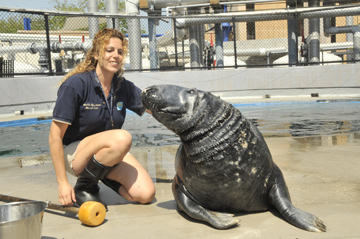Meet Spook, the world’s oldest gray seal
Spook, the gray seal, is a living legend
By Julie and Megan Maher and Joanne Sottile
special to mongabay.com
July 2, 2008
Bringing Spook’s story to life through photographs and words, they hope to inspire the world to know that animal as well as human care has no age limit.
At the age of 43, Spook is the oldest gray seal on record at any aquarium or zoo in the world. He has surpassed his gray seal relatives in the wild that can live to 30 years of age. Spook may be a senior citizen among seals, but retirement is not on his radar.
Born on January 13, 1965, at the Wildlife Conservation Society’s New York Aquarium in Brooklyn, New York, Spook began his life as a record breaker. He was the first gray seal ever born in an aquarium or zoo. Through the years, Spook has lived a full life at the Aquarium, and continues to thrive in his golden years, thanks to special care from his wild animal trainer, Joanne Sottile, and the Aquarium staff.
Spook’s gray seal lineage comes from the large side of the pinniped (fin-footed marine mammals) family tree. He is eight feet long and weighs 750 pounds.
 Spook, the gray seal, and trainer Joanne. Photo by Julie Larsen Maher |
As a male, he has the species’ distinctive giant bending nose. When floating at the top of the water, it is easy to see why these seals have acquired interesting nicknames like horsehead and their scientific name derived from the Greek words Halichoerus grypus, meaning hook-nosed pig.
In Spook’s senior seal years, his trainers and caregivers at the Aquarium have come up with unique ways to keep him happy and comfortable. They use enrichment (anything that mentally or physically stimulates an animal) to maintain his natural behaviors. Joanne spearheads her group in creating opportunities for Spook to learn and that challenge him to problem solve.
Even though Spook lives in New York, he has the inherent foraging behavior of his wild relatives. Gray seals in the wild live in the frigid, subarctic waters on both sides of North America, reaching to the Baltic Sea. These seals fish for their food by diving down 475 feet in the cold waters where they can stay for up to 20 minutes at a time. Joanne simulates a fish search for Spook by scattering them all around his exhibit (both in the water and on land.) She hides fish inside his toys and puts them inside frozen blocks of ice. Spook is an expert fish finder, and uses all his special adaptations to catch them, including his bristly whiskers.
In nature, seals use their whiskers, called vibrissae, to locate food in the deep, dark, murky sea. By tossing fish into the water, Joanne and the trainers give Spook the chance to put his whiskers into action detecting the vibrations that the fish send out. His fancy for fishing on Joanne’s enrichment expedition provides him with all the exercise he needs.
 Spook, the gray seal. Photo by Julie Larsen Maher |
In his advanced years, maintaining and monitoring Spook’s health is particularly important. Spook has been trained to assist the Aquarium staff in his medical care by doing various behaviors. Spook comes out of the water and lays in different positions that allow an examination of his body. He has learned to remain still so the veterinarians can give him his regular preventative vaccinations. Spook can open his mouth, like a big yawn, when Joanne or another caregivers ask him, allowing them to examine his teeth and gums.
Due to his advanced age, Spook has poor eyesight and needs regular applications of eye drops. Joanne has guided him to accept routine continuing care through the sensation of touch. A gently placed stroke by Joanne’s hand lets him know what to expect.
In his role as an ambassador of marine mammals everywhere, Spook has also become a marine “model”. Joanne has conditioned him to accept other people with their digital camera gear in his area, and all the clicks and flashes that come with it. Sudden movements and changes in Spook’s environment could be stressful. Joanne and her staff had practice sessions with him in advance of photo sessions to acclimate him to having his picture taken. Respect for the animal, listening to the trainers and their knowledge of wildlife behavior, a variety of lenses, and patience get a good picture. The photos of Spook and Joanne serve as a visual voice for news and to inform and educate of others about his behavior.
 Spook, the gray seal. Photo by Julie Larsen Maher |
Spook is a very special animal. Since he is the first gray seal born and oldest to live at an aquarium or zoo, Spook has taught Joanne and her colleagues a lot about his species as a whole, and that animal as well as human care has no age limit.
Three hundred years ago, gray seals were nearly hunted to extinction as a source of oil (like whale oil.) In the late 20th century, the gray seal’s plight worsened as fishermen found them in competition for their fish. Through education and animals like Spook, there is hope that times like these are in the past.
Spook is an emissary for gray seals and all marine mammals. He has inspired several generations of people to support conservation of our planet. Protecting gray seal habitat including the rocky shorelines and their surrounding seas helps save killer whales, harbor seals, and other species that belong to this vital web of life.













